An Investigation of the Accuracy of EC5 and 5TE Capacitance Sensors for Soil Moisture Monitoring in Urban Soils-Laboratory and Field Calibration
Abstract
1. Introduction
2. Materials and Methods
2.1. Description of the Study Site and Instrumentation
2.2. Sensor to Sensor Variability and Repeatability
2.3. Sensors Calibration
2.3.1. Overview of the Different Calibration Procedures and Methods
2.3.2. Calibration Methods Applied in this Study
The Standard Direct Calibration Method
Direct Laboratory Calibration on Undisturbed Sample
Field Calibration
2.4. Data Analysis
3. Results and Discussion
3.1. Repeatability and Sensor to Sensor Variability
3.2. Accuracy of Manufacturer Calibration
3.3. Comparison of Results from Different Direct Calibration Methods
3.4. Comparison of Direct and Indirect Calibration Procedures
3.5. Evaluation of the Uncertainty of Prediction of Soil Moisture Measurement
4. Conclusions
Author Contributions
Funding
Acknowledgments
Conflicts of Interest
Appendix A


References
- Eagleman, J.R.; Lin, W.C. Remote sensing of soil moisture by a 21-cm passive radiometer. J. Geophys. Res. 1976, 81, 3660–3666. [Google Scholar] [CrossRef]
- Kaleita, A.L.; Tian, L.F.; Hirschi, M.C. Relationship between soil moisture content and soil surface reflectance. Trans. ASAE 2005, 48, 1979–1986. [Google Scholar] [CrossRef]
- Njoku, E.G.; Entekhabi, D. Passive microwave remote sensing of soil moisture. J. Hydrol. 1996, 184, 101–129. [Google Scholar] [CrossRef]
- Robinson, D.A.; Jones, S.B.; Wraith, J.M.; Or, D.; Friedman, S.P. A review of advances in dielectric and electrical conductivity measurement in soils using time domain reflectometry. Vadose Zone J. 2003, 2, 444–475. [Google Scholar] [CrossRef]
- Dalton, F.N.; Van Genuchten, M.T. The time-domain reflectometry method for measuring soil water content and salinity. Geoderma 1986, 38, 237–250. [Google Scholar] [CrossRef]
- Bell, J.P.; Dean, T.J.; Hodnett, M.G. Soil moisture measurement by an improved capacitance technique, Part II. Field techniques, evaluation and calibration. J. Hydrol. 1987, 93, 79–90. [Google Scholar] [CrossRef]
- Dean, T.J.; Bell, J.P.; Baty, A.J.B. Soil moisture measurement by an improved capacitance technique, Part I. Sensor design and performance. J. Hydrol. 1987, 93, 67–78. [Google Scholar] [CrossRef]
- Eller, H.; Denoth, A. A capacitive soil moisture sensor. J. Hydrol. 1996, 185, 137–146. [Google Scholar] [CrossRef]
- Fares, A.; Alva, A.K. Soil water components based on capacitance probes in a sandy soil. Soil Sci. Soc. Am. J. 2000, 64, 311–318. [Google Scholar] [CrossRef]
- Evett, S.R.; Ruthardt, B.B.; Kottkamp, S.T.; Howell, T.A.; Schneider, A.D.; Tolk, J.A. Accuracy and precision of soil water measurements by neutron, capacitance, and TDR methods. In Proceedings of the 17th Water Conservation Soil Society Symposium, Bangkok, Thailand, 14–21 August 2002. [Google Scholar]
- Topp, G.C.; Davis, J.L.; Annan, A.P. Electromagnetic determination of soil water content: Measurements in coaxial transmission lines. Water Resour. Res. 1980, 16, 574–582. [Google Scholar] [CrossRef]
- Bogena, H.R.; Huisman, J.A.; Oberdörster, C.; Vereecken, H. Evaluation of a low-cost soil water content sensor for wireless network applications. J. Hydrol. 2007, 344, 32–42. [Google Scholar] [CrossRef]
- Fares, A.; Safeeq, M.; Awal, R.; Fares, S.; Dogan, A. Temperature and Probe-to-Probe Variability Effects on the Performance of Capacitance Soil Moisture Sensors in an Oxisol. Vadose Zone J. 2016, 15. [Google Scholar] [CrossRef]
- Payero, J.O.; Qiao, X.; Khalilian, R.D.; Davis, R. Impact of soil texture on the performance of three soil moisture sensor types. In 2014 Montreal, Quebec Canada July 13–July 16, 2014; American Society of Agricultural and Biological Engineers: St. Joseph, MI, USA, 2014; p. 1. [Google Scholar]
- Seyfried, M.S.; Grant, L.E. Temperature Effects on Soil Dielectric Properties Measured at 50 MHz. Vadose Zone J. 2007, 6, 759–765. [Google Scholar] [CrossRef]
- Bañón, S.; Ochoa, J.; Bañón, D.; Ortuño, M.F.; Sánchez-Blanco, M.J. Assessment of the Combined Effect of Temperature and Salinity on the Outputs of Soil Dielectric Sensors in Coconut Fiber. Sustainability 2020, 12, 6577. [Google Scholar] [CrossRef]
- Scoggins, H.L.; van Iersel, M.W. In situ probes for measurement of electrical conductivity of soilless substrates: Effects of temperature and substrate moisture content. HortScience 2006, 41, 210–214. [Google Scholar] [CrossRef]
- Kizito, F.; Campbell, C.S.; Campbell, G.S.; Cobos, D.R.; Teare, B.L.; Carter, B.; Hopmans, J.W. Frequency, electrical conductivity and temperature analysis of a low-cost capacitance soil moisture sensor. J. Hydrol. 2008, 352, 367–378. [Google Scholar] [CrossRef]
- Mittelbach, H.; Casini, F.; Lehner, I.; Teuling, A.J.; Seneviratne, S.I. Soil moisture monitoring for climate research: Evaluation of a low-cost sensor in the framework of the Swiss Soil Moisture Experiment (SwissSMEX) campaign. J. Geophys. Res. 2011, 116, D5. [Google Scholar] [CrossRef]
- Abbas, F.; Fares, A.; Fares, S. Field Calibrations of Soil Moisture Sensors in a Forested Watershed. Sensors 2011, 11, 6354–6369. [Google Scholar] [CrossRef]
- Ganjegunte, G.K.; Sheng, Z.; Clark, J.A. Evaluating the accuracy of soil water sensors for irrigation scheduling to conserve freshwater. Appl. Water Sci. 2012, 2, 119–125. [Google Scholar] [CrossRef]
- Kinzli, K.-D.; Manana, N.; Oad, R. Comparison of laboratory and field calibration of a soil-moisture capacitance probe for various soils. J. Irrig. Drain. Eng. 2011, 138, 310–321. [Google Scholar] [CrossRef]
- Mittelbach, H.; Lehner, I.; Seneviratne, S.I. Comparison of four soil moisture sensor types under field conditions in Switzerland. J. Hydrol. 2012, 430–431, 39–49. [Google Scholar] [CrossRef]
- Rosenbaum, U.; Huisman, J.A.; Weuthen, A.; Vereecken, H.; Bogena, H.R. Sensor-to-Sensor Variability of the ECHO EC-5, TE, and 5TE Sensors in Dielectric Liquids. Vadose Zone J. 2010, 9, 181. [Google Scholar] [CrossRef]
- Singh, J.; Lo, T.; Rudnick, D.R.; Dorr, T.J.; Burr, C.A.; Werle, R.; Shaver, T.M.; Muñoz-Arriola, F. Performance assessment of factory and field calibrations for electromagnetic sensors in a loam soil. Agric. Water Manag. 2018, 196, 87–98. [Google Scholar] [CrossRef]
- Sharma, H.; Shukla, M.K.; Bosland, P.W.; Steiner, R. Soil moisture sensor calibration, actual evapotranspiration, and crop coefficients for drip irrigated greenhouse chile peppers. Agric. Water Manag. 2017, 179, 81–91. [Google Scholar] [CrossRef]
- Spelman, D.; Kinzli, K.-D.; Kunberger, T. Calibration of the 10HS Soil Moisture Sensor for Southwest Florida Agricultural Soils. J. Irrig. Drain. Eng. 2013, 139, 965–971. [Google Scholar] [CrossRef]
- Varble, J.L.; Chávez, J.L. Performance evaluation and calibration of soil water content and potential sensors for agricultural soils in eastern Colorado. Agric. Water Manag. 2011, 101, 93–106. [Google Scholar] [CrossRef]
- METER Group. ECH2O EC-5 Manual; METER Group: Pullman, WA, USA, 2018. [Google Scholar]
- METER Group. ECH2O 5TE Manual; METER Group: Pullman, WA, USA, 2018. [Google Scholar]
- Davis, A.P. Green Engineering Promote Low-Impact Development. Environ. Sci. Technol. 2005, 39, 338A–344A. [Google Scholar] [CrossRef]
- Sakaki, T.; Limsuwat, A.; Smits, K.M.; Illangasekare, T.H. Empirical two-point α -mixing model for calibrating the ECH2O EC-5 soil moisture sensor in sands: TWO-POINT α -MIXING MODEL. Water Resour. Res. 2008, 44. [Google Scholar] [CrossRef]
- Robinson, D.A.; Gardner, C.M.K.; Evans, J.; Cooper, J.D.; Hodnett, M.G.; Bell, J.P. The dielectric calibration of capacitance probes for soil hydrology using an oscillation frequency response model. Hydrol. Earth Syst. Sci. Discuss. 1998, 2, 111–120. [Google Scholar] [CrossRef]
- Seyfried, M.S.; Murdock, M.D. Measurement of soil water content with a 50-MHz soil dielectric sensor. Soil Sci. Soc. Am. J. 2004, 68, 394–403. [Google Scholar] [CrossRef]
- Bircher, S.; Andreasen, M.; Vuollet, J.; Vehviläinen, J.; Rautiainen, K.; Jonard, F.; Weihermüller, L.; Zakharova, E.; Wigneron, J.-P.; Kerr, Y.H. Soil moisture sensor calibration for organic soil surface layers. Geosci. Instrum. Methods Data Syst. 2016, 5, 109–125. [Google Scholar] [CrossRef]
- Vaz, C.M.P.; Jones, S.; Meding, M.; Tuller, M. Evaluation of Standard Calibration Functions for Eight Electromagnetic Soil Moisture Sensors. Vadose Zone J. 2013, 12, 1–16. [Google Scholar] [CrossRef]
- Visconti, F.; de Paz, J.M.; Martínez, D.; Molina, M.J. Laboratory and field assessment of the capacitance sensors Decagon 10HS and 5TE for estimating the water content of irrigated soils. Agric. Water Manag. 2014, 132, 111–119. [Google Scholar] [CrossRef]
- Jones, S.B.; Blonquist, J.M.; Robinson, D.A.; Rasmussen, V.P.; Or, D. Standardizing characterization of electromagnetic water content sensors. Vadose Zone J. 2005, 4, 1048–1058. [Google Scholar] [CrossRef]
- Gasch, C.K.; Brown, D.J.; Brooks, E.S.; Yourek, M.; Poggio, M.; Cobos, D.R.; Campbell, C.S. A pragmatic, automated approach for retroactive calibration of soil moisture sensors using a two-step, soil-specific correction. Comput. Electron. Agric. 2017, 137, 29–40. [Google Scholar] [CrossRef]
- Kanso, T.; Tedoldi, D.; Gromaire, M.-C.; Ramier, D.; Saad, M.; Chebbo, G. Horizontal and Vertical Variability of Soil Hydraulic Properties in Roadside Sustainable Drainage Systems (SuDS)—Nature and Implications for Hydrological Performance Evaluation. Water 2018, 10, 987. [Google Scholar] [CrossRef]
- Cronshey, R. Urban hydrology for small watersheds. Tech. Release 1986, 55, 2–6. [Google Scholar]
- Parsons, L.R.; Bandaranayake, W.M. Performance of a New Capacitance Soil Moisture Probe in a Sandy Soil. Soil Sci. Soc. Am. J. 2009, 73, 1378. [Google Scholar] [CrossRef]
- Robinson, D.A.; Jones, S.B.; Blonquist, J.M.; Friedman, S.P. A physically derived water content/permittivity calibration model for coarse-textured, layered soils. Soil Sci. Soc. Am. J. 2005, 69, 1372–1378. [Google Scholar] [CrossRef]
- Starr, J.L.; Paltineanu, I.C. Methods for measurement of soil water content: Capacitance devices. Methods Soil Anal. Part 4 Phys. Methods 2002, 4, 463–474. [Google Scholar]
- Cobose, D.R.; Chambers, C. Calibrating ECH2O soil moisture sensors. Decagon Devices Pullman WA. 2010. ApplicationNote. 1–5. Available online: https://assets.tequipment.net/assets/1/26/Calibrating_ECH2O_Soil_Moisture_Sensors.pdf (accessed on 13 November 2020).
- Topp, G.C.; Ferré, P.A. Determination of water content. Methods Soil Anal. 2002, 4, 417–545. [Google Scholar]
- Logsdon, S.D. CS616 Calibration: Field versus Laboratory. Soil Sci. Soc. Am. J. 2009, 73, 1–6. [Google Scholar] [CrossRef]
- RoTimi Ojo, E.; Bullock, P.R.; Fitzmaurice, J. Field Performance of Five Soil Moisture Instruments in Heavy Clay Soils. Soil Sci. Soc. Am. J. 2015, 79, 20. [Google Scholar] [CrossRef]
- Assouline, S.; Narkis, K.; Tyler, S.W.; Lunati, I.; Parlange, M.B.; Selker, J.S. On the Diurnal Soil Water Content Dynamics during Evaporation Using Dielectric Methods. Vadose Zone J. 2010, 9, 709. [Google Scholar] [CrossRef]
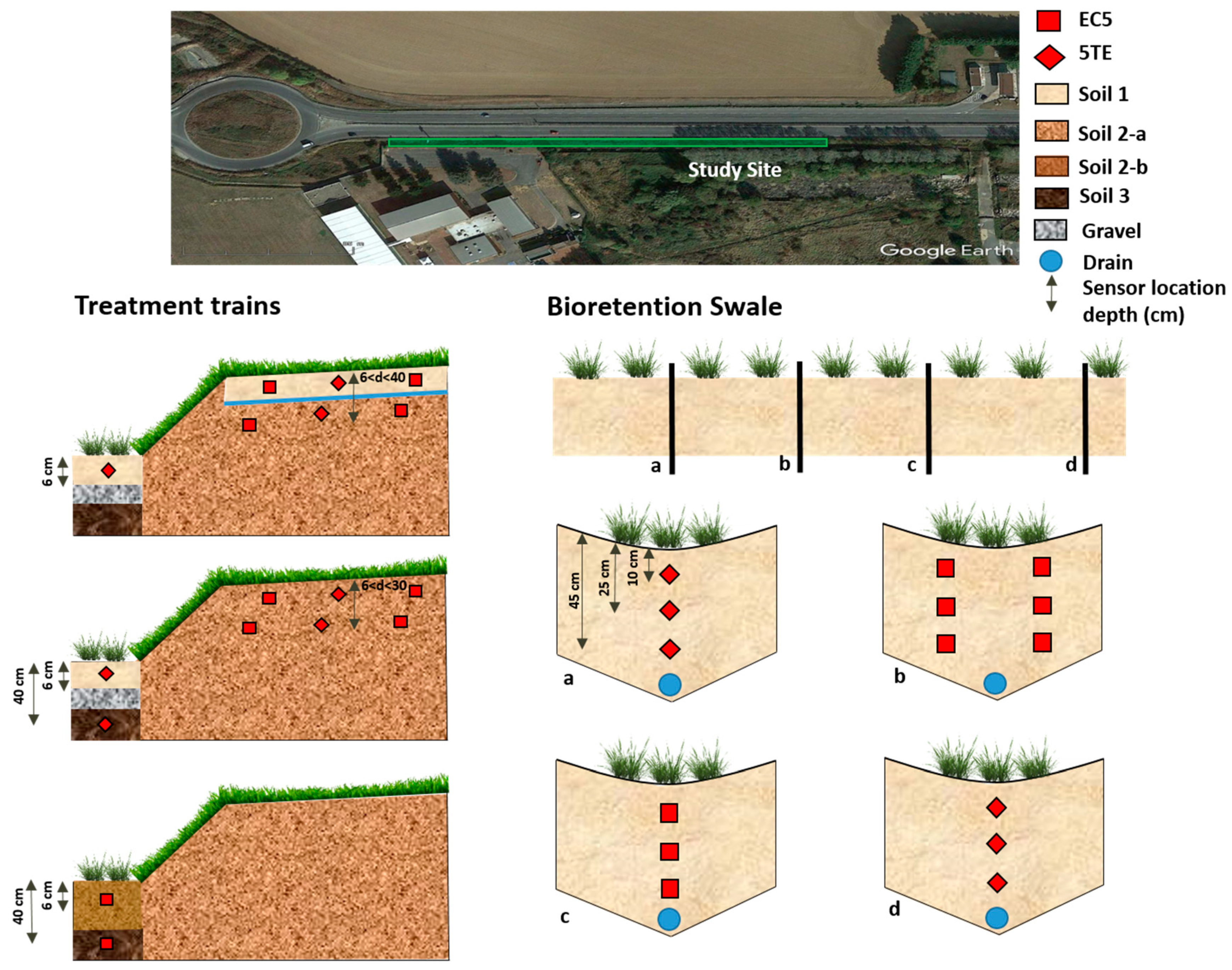

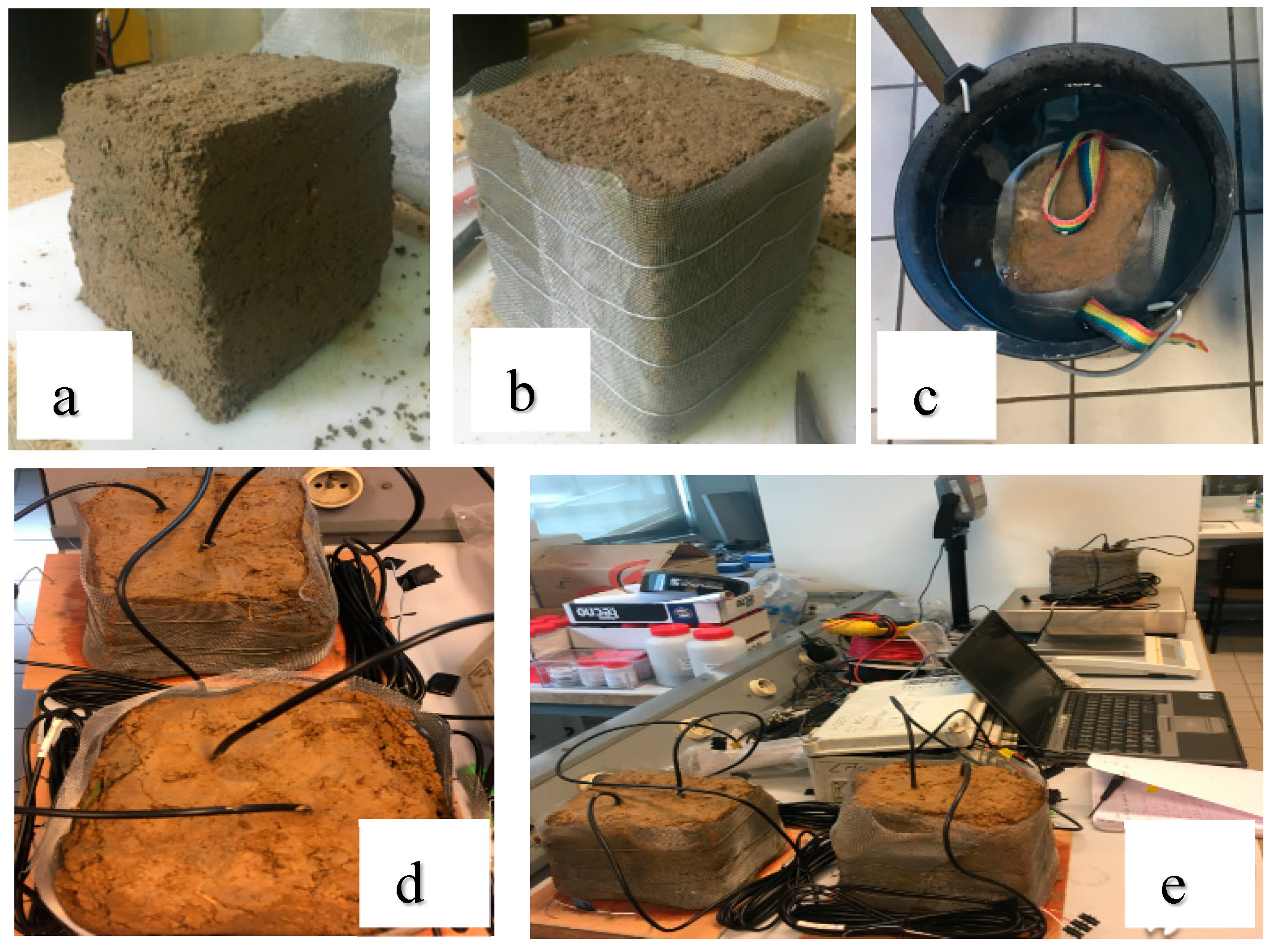


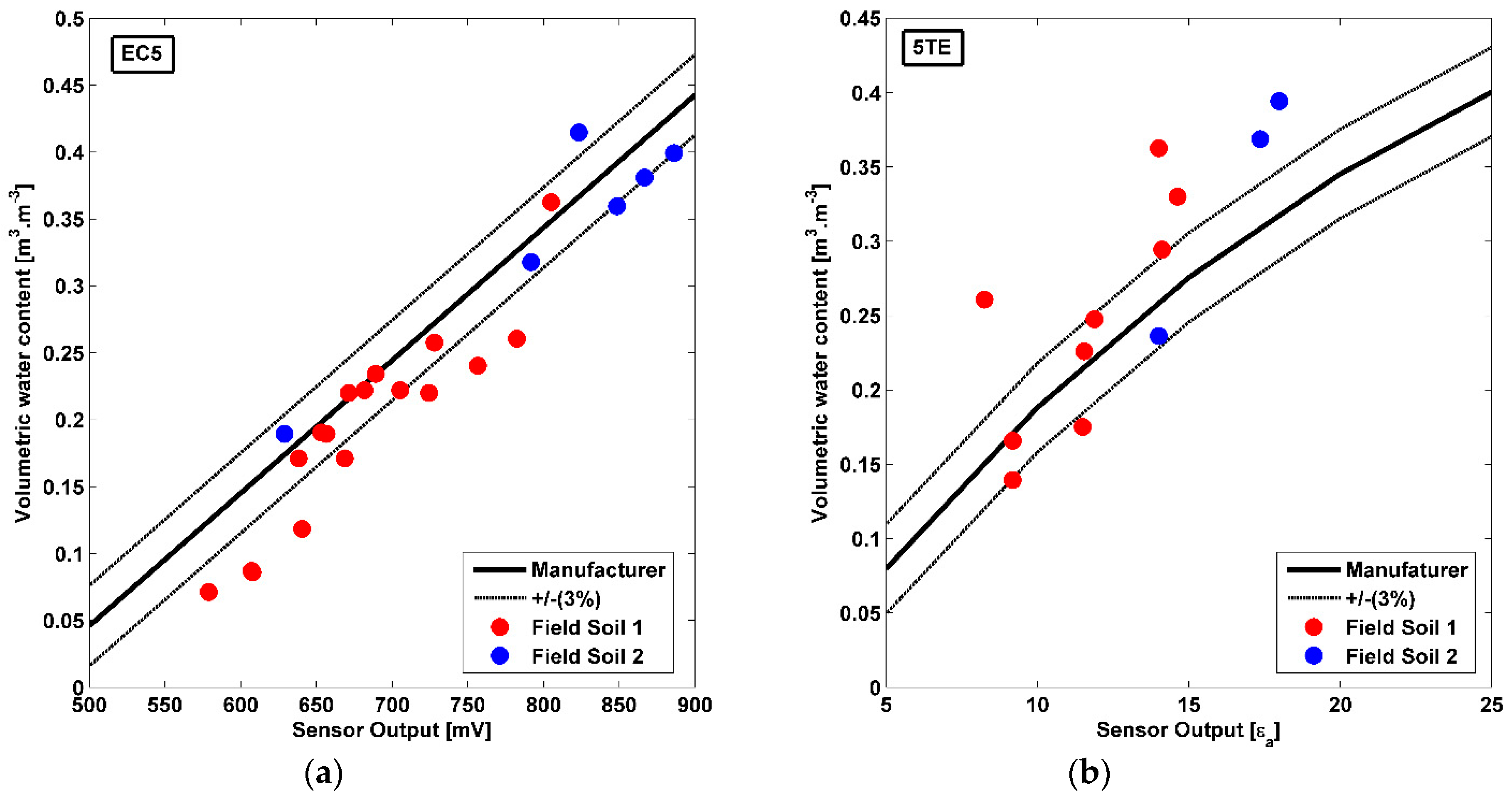
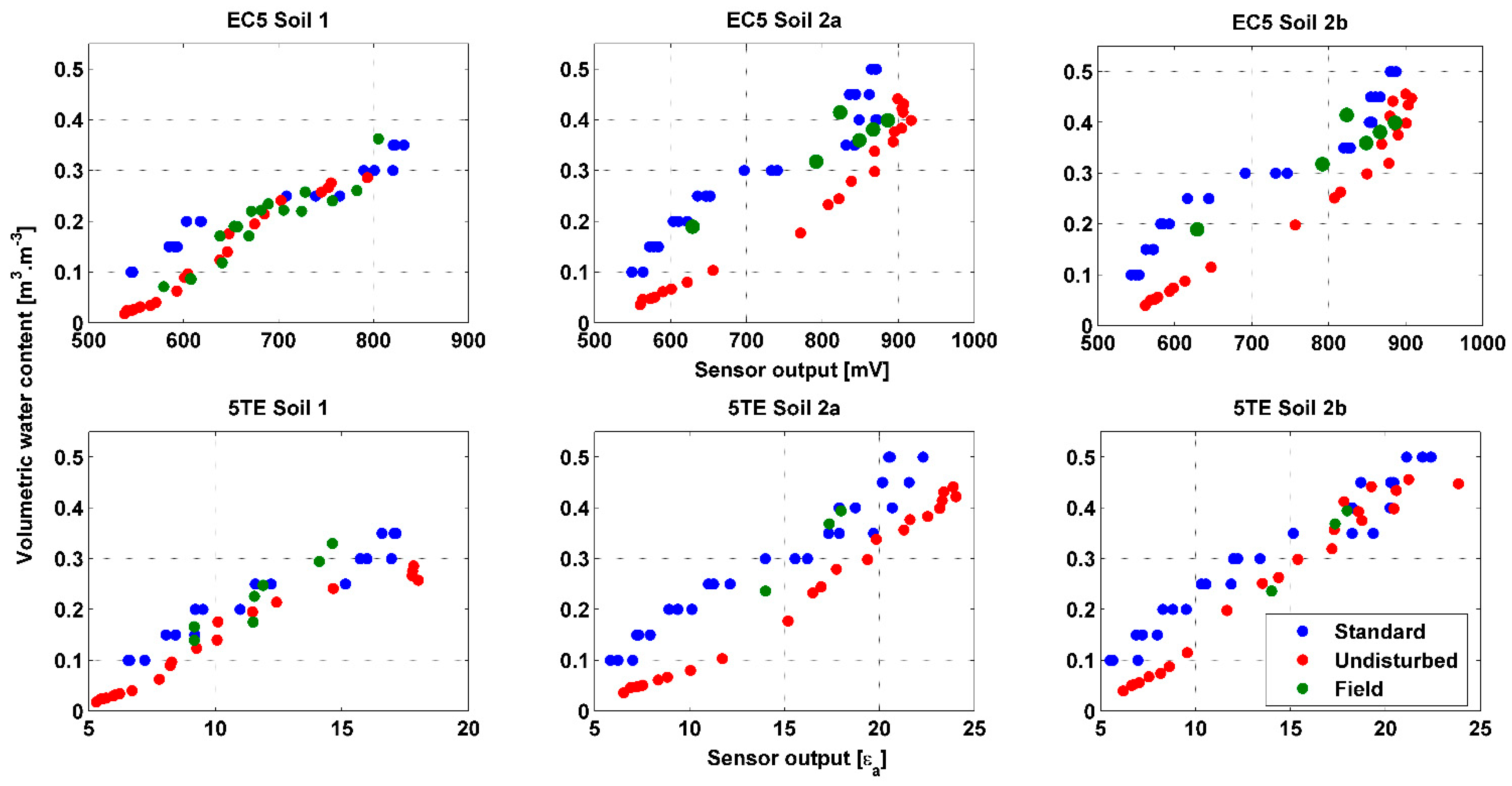
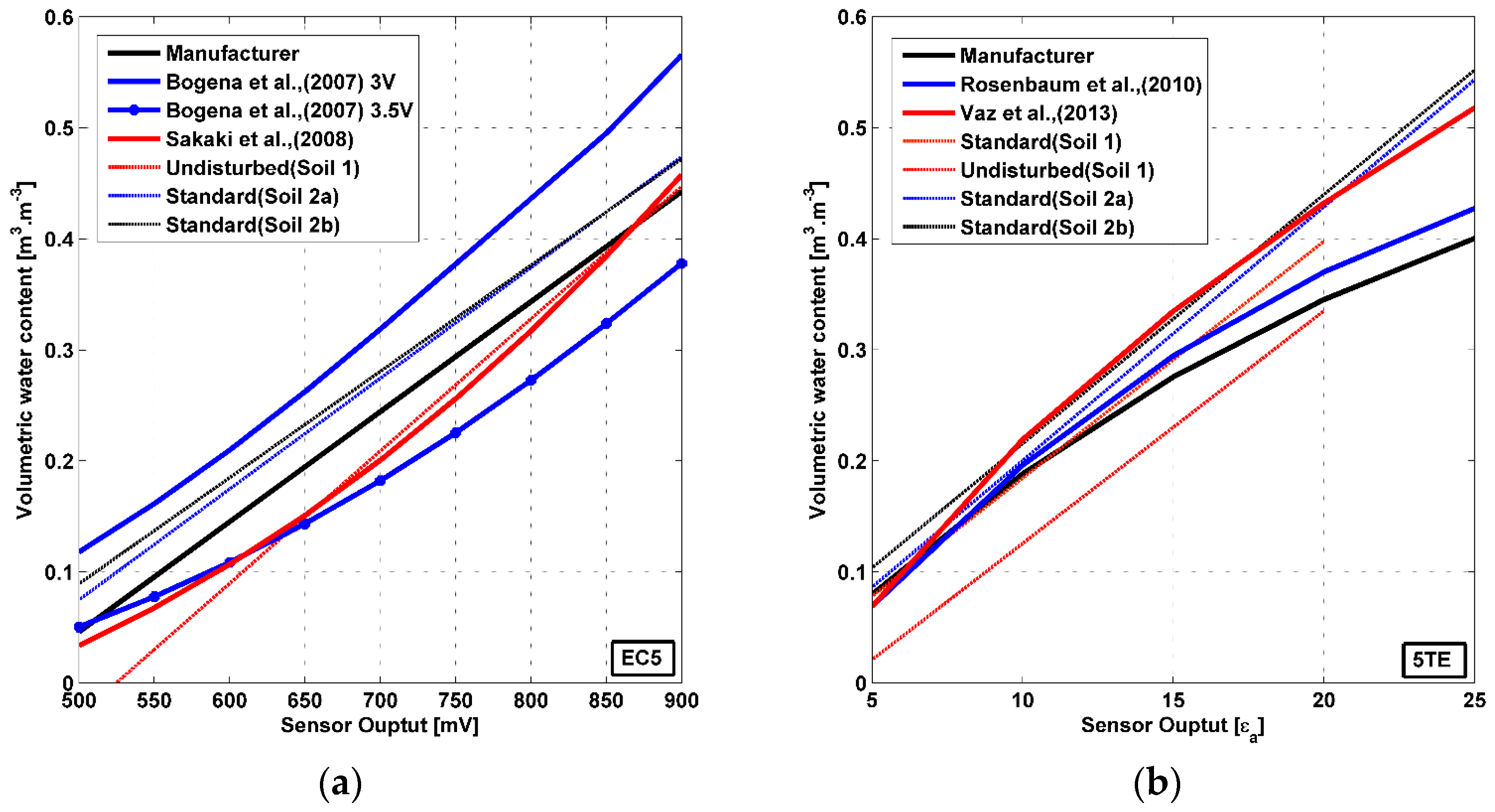

| EC5 | 5TE | |
|---|---|---|
| Measurement range | VWC (volumetric water content) (%): 0 to 100 T ( °C): 0 to 50 | εa: 1 to 80 ECb (dS∙m−1): 0 to 23 T ( °C): −40 to 60 |
| Number of prongs | 2 | 3 |
| Length, width, depth (cm) | 8.9,1.8,0.7 | 10,3.7,0.7 |
| Power supply | 2.5 to 3.6 V | 3.6 to 15 V |
| Output type | mV (Non METER data logger) RAW = mV/0.732 (METER data logger) | εa, ECb, T (SDI-12 communication mode) εRAW, ECb, TRAW (DDI serial) εRAW = εa × 50 TRAW = 10 T + 400 (if T ≤ 50) ( °C) TRAW = 2 T + 800 (if T > 50) ( °C) |
| Output format | Analog and dependent of the supply voltage | Digital and independent of the supply voltage |
| Measurement volume (cm3)/diameter (cm)/ Dimensions (axbxh cm) | 240 cm3/5.5 cm/ (5 × 5.5 × 9) (Manufacturer) 18 cm3 [32] 15 cm3 [42] | 715 cm3/ 8.6 cm/(7 × 11 × 10) (Manufacturer) 79 cm3 [36] |
| Accuracy VWC, ECb, T | ±3% | ±3% ([11] equation), ±10%, ±1 |
| Sensor | Equation No. | Source | Procedure | Method | Equation | Accuracy in VWC ( ± m3∙m−3) and R2 |
|---|---|---|---|---|---|---|
| EC5 | (2) | Manufacturer [29,30] | Direct | Standard calibration for mineral soils [44] | 2.5 V supply voltage 3.3 V supply voltage | ±0.03 |
| (3) | [32] | Direct | Long column drainage experiment using four industrial silica sands | is the porosity of the soil α = 2.5 is the geometry factor | R2=0.973 | |
| (4) | [12] | Two-step | First step: [38] method, liquids used are Dioxane (1,4-diethylene dioxide) and 2-isopropoxyethanol (i-C3E1) mixed with water. Second step: [11] | Fitting parameters for a 3 V supply voltage: = −0.03128; = 0.04148; (3 V) = −0.78628 Fitting parameters for a 3.5 V supply voltage: = −0.04173; = 0.06855; (3.5 V) = −0.49469; [11] | ±0.0178 | |
| 5TE | (5) | Manufacturer [29,30] | Two-step | First step: Calibration in air, glass beads saturated with ethylene glycol and pure ethylene glycol Second step: [11] | εa = εRAW/50 [11] | ±0.03 |
| (6) | [24] | Two-step | Same procedure as [12] | ±0.010 | ||
| (7) | [36] | Direct | Standard calibration method for mineral soils bulk densities: 1–1.5 g∙cm3 Textural class ([41]): Sand/Sandy loam/silt loam/ loam | ±0.026 |
| N = 30 Repeated Measurements for Each Sensor | |||||
|---|---|---|---|---|---|
| Sensor | Number of Sensors (N) | Soil | Mean per Sensor | SD per Sensor | CV (%) |
| Min–Max (N Values) | |||||
| EC5 (mV) | 11 | Soil1 | 682–803 | 1.2 × 10−13–0.3 | 1.7 × 10−14–0.04 |
| 6 | Soil 2-a | 716–868 | 0.06–0.37 | 0.01–0.04 | |
| 1 | Soil 2-b | 876 | 5.6 × 10−13 | 6.6 × 10−14 | |
| 1 | Soil 3 | 875 | 0.07 | 0.01 | |
| 5TE (εa) | 9 | Soil1 | 12.5–16.8 | 1.1 × 10−14–0.016 | 6.4 × 10−14–0.12 |
| 3 | Soil 2-a | 7.7–18.4 | 0–0.01 | 0–0.04 | |
| 1 | Soil 3 | 18.8 | 0.01 | 0.04 | |
| Sensor | Number of Sensors | Standards (Theoretical Value) | Mean Response (mV for EC5, εa for 5TE) | SD | CV (%) |
|---|---|---|---|---|---|
| EC5 (mV) | 9 sensors | Air | 344.2 | 3.5 | 1 |
| Water | 1033.3 | 6.9 | 0.7 | ||
| Pure Ethylene Glycol | 1001.5 | 5.8 | 0.6 | ||
| 5TE (εa) | 6 sensors | Air (1) | 1.3 | 0.4 | 28.2 |
| Water (81.4) | 70 | 5.7 | 8.2 | ||
| Pure Ethylene Glycol (32.9–37) | 40.7 | 3.2 | 7.8 |
| R2 | RMSE m3∙m−3 | Fitting Parameters | R2 | RMSE m3∙m−3 | ||||||
|---|---|---|---|---|---|---|---|---|---|---|
| EC5 soil 1 | a | b | a | b | c | d | ||||
| Standard | 0.0007626 | −0.2979 | 0.94 | 0.022 | 2.5 × 10−8 | −5.2 × 10−5 | 0.036 | −8.3 | 0.97 | 0.016 |
| Undisturbed | 0.001192 | −0.6255 | 0.97 | 0.016 | −2.8 × 10−8 | 5.3 × 10−5 | −0.033 | 6.496 | 0.99 | 0.0097 |
| Field | 0.001104 | −0.5576 | 0.86 | 0.029 | 4.2 × 10−8 | −8.8 × 10−5 | 0.063 | −14.95 | 0.89 | 0.027 |
| EC5 soil 2 a | ||||||||||
| Standard | 0.0009982 | −0.4242 | 0.92 | 0.038 | 2.4 × 10−8 | −5.3 × 10−5 | 0.038 | −9.096 | 0.94 | 0.035 |
| Undisturbed | 0.001051 | −0.5691 | 0.95 | 0.034 | 8.7 × 10−9 | −1.7 × 10−5 | 0.011 | −2.537 | 0.99 | 0.019 |
| Field | 0.0008297 | −0.3263 | 0.88 | 0.032 | −3.9 × 10−8 | 9 × 10−5 | −0.067 | 16.38 | 0.9 | 0.041 |
| EC5 soil 2b | ||||||||||
| Standard | 0.000957 | −0.3892 | 0.94 | 0.033 | 3.6 × 10−8 | −7.8 × 10−5 | 0.056 | −13 | 0.99 | 0.015 |
| Undisturbed | 0.001103 | −0.591 | 0.96 | 0.034 | 1.3 × 10−8 | −2.5 × 10−5 | 0.018 | −4.183 | 0.98 | 0.024 |
| Field | 0.0008297 | −0.3263 | 0.88 | 0.032 | −3.9 × 10−8 | 9 × 10−5 | −0.067 | 16.38 | 0.9 | 0.041 |
| 5TE soil 1 | ||||||||||
| Standard | 0.02131 | −0.0284 | 0.93 | 0.023 | 0.00033 | −0.01221 | 0.165 | −0.562 | 0.95 | 0.022 |
| Undisturbed | 0.02095 | −0.0838 | 0.95 | 0.022 | −0.00017 | 0.004784 | −0.014 | −0.019 | 0.99 | 0.011 |
| Field | 0.03134 | −0.1415 | 0.9 | 0.024 | −0.00057 | 0.02198 | −0.248 | 1.01 | 0.91 | 0.029 |
| 5TE soil 2a | ||||||||||
| Standard | 0.02285 | −0.028 | 0.95 | 0.030 | 0.000108 | −0.00443 | 0.078 | −0.238 | 0.96 | 0.03 |
| Undisturbed | 0.02327 | −0.1361 | 0.99 | 0.018 | −6.2∙10−5 | 0.003407 | −0.033 | 0.134 | 0.99 | 0.01 |
| Field | 0.03962 | −0.3184 | 1 | 0.0003 | - | - | - | - | - | - |
| 5TE soil 2b | ||||||||||
| Standard | 0.02242 | −0.0084 | 0.95 | 0.03 | 0.000104 | −0.004594 | 0.085 | −0.263 | 0.96 | 0.03 |
| Undisturbed | 0.02728 | −0.1309 | 0.97 | 0.026 | −0.00011 | 0.004399 | −0.025 | 0.054 | 0.99 | 0.019 |
| Field | 0.03962 | −0.3184 | 1 | 0.0003 | - | - | - | - | - | - |
Publisher’s Note: MDPI stays neutral with regard to jurisdictional claims in published maps and institutional affiliations. |
© 2020 by the authors. Licensee MDPI, Basel, Switzerland. This article is an open access article distributed under the terms and conditions of the Creative Commons Attribution (CC BY) license (http://creativecommons.org/licenses/by/4.0/).
Share and Cite
Kanso, T.; Gromaire, M.-C.; Ramier, D.; Dubois, P.; Chebbo, G. An Investigation of the Accuracy of EC5 and 5TE Capacitance Sensors for Soil Moisture Monitoring in Urban Soils-Laboratory and Field Calibration. Sensors 2020, 20, 6510. https://doi.org/10.3390/s20226510
Kanso T, Gromaire M-C, Ramier D, Dubois P, Chebbo G. An Investigation of the Accuracy of EC5 and 5TE Capacitance Sensors for Soil Moisture Monitoring in Urban Soils-Laboratory and Field Calibration. Sensors. 2020; 20(22):6510. https://doi.org/10.3390/s20226510
Chicago/Turabian StyleKanso, Tala, Marie-Christine Gromaire, David Ramier, Philippe Dubois, and Ghassan Chebbo. 2020. "An Investigation of the Accuracy of EC5 and 5TE Capacitance Sensors for Soil Moisture Monitoring in Urban Soils-Laboratory and Field Calibration" Sensors 20, no. 22: 6510. https://doi.org/10.3390/s20226510
APA StyleKanso, T., Gromaire, M.-C., Ramier, D., Dubois, P., & Chebbo, G. (2020). An Investigation of the Accuracy of EC5 and 5TE Capacitance Sensors for Soil Moisture Monitoring in Urban Soils-Laboratory and Field Calibration. Sensors, 20(22), 6510. https://doi.org/10.3390/s20226510








